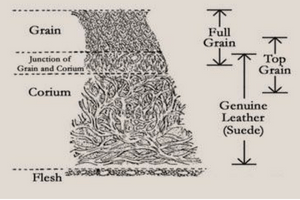What Type of Leather is Best?
When it comes to leather there are more options than you might have imagined, which can be confusing when trying to decide what to purchase. The leather industry doesn’t do any favors in this regard, obscuring the types and amounts of leather used for various applications. Below find a brief rundown of what’s on the market and how to distinguish one from the other.
It’s helpful to first have an understanding of what leather is: the hide of an animal. Most quality leather you encounter will be a byproduct of the US beef industry; repurposed from cows that have been raised for food these skins are high quality and well-maintained.

Notice in the figure above that there are tightly packed fibers at the surface, which give way to looser fibers down below. Each type of leather exists somewhere on this spectrum (with a few exceptions which will be covered below).
Full Grain
The mac daddy of all leathers, full-grain is untreated, uncorrected, 100% animal hide. It retains all the toughness of the tightly packed surface fibers and even shows scars and markings where the cow may have been bitten or caught on barbed wire. This leather is hard to work with and very expensive. Its durability makes it perfect for any application including furniture, handbags, wallets, shoes, and more.
Full Grain leather will wear in nicely over time, developing a patina. It is very soft to the touch but still tough. It’s important to note that this leather will not have a uniform look because the surface has been subjected to a lifetime out on the range. Buy full grain leather as a lifelong investment if you’re prepared to care for it properly (which means regular conditioning and avoiding extended periods of direct sunlight).
Top Grain
This is the next best thing in terms of quality and is also known as ‘corrected’ leather. The surface is sanded or buffed away so that the remaining layer is uniform in appearance. The enhanced look comes at the expense of durability as the top layer of tightly packed fibers is shorn off.
Top Grain leather is typically referred to as aniline or semi-aniline. The former is leather that has been dyed, but not treated in any other way. The later has been dyed and also given a protective coating. This makes it less susceptible to staining but also takes away some of the softness that leather is known for.
Split Grain
Taking another step down we get split grain, which is the lower layer of leather. It is cheaper, and also more fragile than its top and full grain counterparts. This type of leather will be processed for a uniform look but doesn’t possess the same feel as the more expensive options.
Bicast
During leather production, the layers of hide are separated from one another. If a layer is too thin or flawed for standard use, manufacturers will repurpose it as bicast leather. The hide is coated entirely in polyurethane for color and preservation. This means that although it retains the look of leather, there is no actual point of contact between the leather and your skin. Naturally, it doesn’t have the same feel and wear-in attributes as top or full grain leather.
Because it’s much easier to clean (being fully coated) and more affordable, bicast leather is a decent option for those who prefer the look of leather but may have budget limitations or a household of children and pets to consider. The durability of bicast leather is minimal, with the first sign of wear being cracking or flaking.
Bonded (barely leather)
Bonded leather needs to contain at least 17% actual leather, but is more like fabric than anything. Scraps from the leather making process are ground together into a pulp and mixed with polyurethane before being flattened into sheets of bonded leather. This product costs manufacturers approximately 5% what they would pay for full grain leather and represents an attractive option to reduce overhead.
Unfortunately, it is often marketed as “genuine leather” or “made with 100% leather” and many consumers don’t know the difference. Bonded leather is fragile and will begin to crack and fade after only a few years. Peeling and flaking are common, and very little can be done to prevent this deterioration. If you’re shopping and come across a bargain (typically at big box home goods stores) you’re likely dealing with bonded leather.
What to buy?
Ultimately, the choice is up to you. Some folks abide by the principle of “buy nice, or buy twice” but we understand not everyone has the budget to get the nicest leather. If you decide to go with a budget alternative, know before you buy that it will begin to deteriorate. Aim for at least a split grain option so you don’t have to deal with peeling and flaking.
Do you know what type of leather you have in your home? Comment below!
[Want to learn more about why leather peels? Click hereOpens a new window]






This information is extremely helpful. Some furniture won’t explain unless asked; will sell you anything.
Thanks for this simple yet informative article. It’s helped me to decide what type of belt to buy for my husband.
Great stuff. Iwantabelt.com has a great article on the 3 T’s of quality leather (kinda like the 4 C’s of diamond quality). Thickness, Tan, & Type. Your article did a great job covering the “type” category. It is also important lo look at the thickness of the leather as well as the kind of tanning process was used. Taken together, you can find what is quality leather.